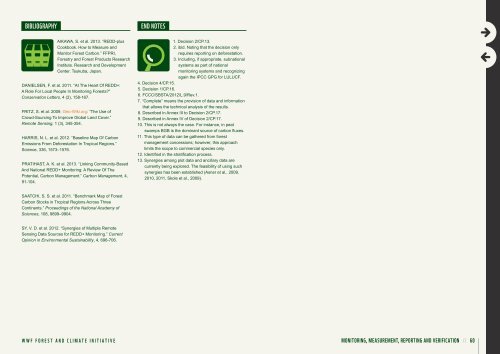WWF Guide to Building REDD+ Strategies
WWF Guide to Building REDD+ Strategies
WWF Guide to Building REDD+ Strategies
Create successful ePaper yourself
Turn your PDF publications into a flip-book with our unique Google optimized e-Paper software.
BiBlioGRaPHy<br />
AIKAWA, S. et al. 2013. “REDD-plus<br />
Cookbook. How <strong>to</strong> Measure and<br />
Moni<strong>to</strong>r Forest Carbon.” FFPRI,<br />
Forestry and Forest Products Research<br />
Institute. Research and Development<br />
Center. Tsukuba, Japan.<br />
DANIELSEN, F. et al. 2011. “At The Heart Of <strong>REDD+</strong>:<br />
A Role For Local People In Moni<strong>to</strong>ring Forests?”<br />
Conservation Letters, 4 (2), 158-167.<br />
FRITZ, S. et al. 2009. Geo-Wiki.org: “The Use of<br />
Crowd-Sourcing To Improve Global Land Cover.”<br />
Remote Sensing, 1 (3), 345-354.<br />
HARRIS, N. L. et al. 2012. “Baseline Map Of Carbon<br />
Emissions From Deforestation In Tropical Regions.”<br />
Science, 336, 1573–1576.<br />
PRATIHAST, A. K. et al. 2013. “Linking Community-Based<br />
And National <strong>REDD+</strong> Moni<strong>to</strong>ring: A Review Of The<br />
Potential, Carbon Management.” Carbon Management, 4,<br />
91-104.<br />
SAATCHI, S. S. et al. 2011. “Benchmark Map of Forest<br />
Carbon S<strong>to</strong>cks in Tropical Regions Across Three<br />
Continents.” Proceedings of the National Academy of<br />
Sciences, 108, 9899–9904.<br />
Sy, V. D. et al. 2012. “Synergies of Multiple Remote<br />
Sensing Data Sources for <strong>REDD+</strong> Moni<strong>to</strong>ring.” Current<br />
Opinion in Environmental Sustainability, 4, 696-706.<br />
end noteS<br />
1. Decision 2/CP.13.<br />
2. ibid. Noting that the decision only<br />
requires reporting on deforestation.<br />
3. Including, if appropriate, subnational<br />
systems as part of national<br />
moni<strong>to</strong>ring systems and recognizing<br />
again the IPCC GPG for LULUCF.<br />
4. Decision 4/CP.15.<br />
5. Decision 1/CP.16.<br />
6. FCCC/SBSTA/2012/L.9/Rev.1.<br />
7. “Complete” means the provision of data and information<br />
that allows the technical analysis of the results.<br />
8. Described in Annex III <strong>to</strong> Decision 2/CP.17.<br />
9. Described in Annex IV of Decision 2/CP.17.<br />
10. This is not always the case. For instance, in peat<br />
swamps BGB is the dominant source of carbon fluxes.<br />
11. This type of data can be gathered from forest<br />
management concessions; however, this approach<br />
limits the scope <strong>to</strong> commercial species only.<br />
12. Identified in the stratification process.<br />
13. Synergies among plot data and ancillary data are<br />
currently being explored. The feasibility of using such<br />
synergies has been established (Asner et al., 2009,<br />
2010, 2011, Skole et al., 2009).<br />
<strong>WWF</strong> FOREST AND CLIMATE INITIATIVE moni<strong>to</strong>RinG, meaSuRement, RePoRtinG and veRiFiCation // 60

















